【C++修行之道】类和对象(五)日期类的实现、const成员、取地址及const和取地址操作符重载
走在努力路上的自己 2024-06-30 15:35:04 阅读 62
目录
一、 日期类的实现
Date.h
1.1 GetMonthDay函数(获取某年某月的天数)
问:这个函数为什么不和其他的函数一样放在Date.cpp文件中实现呢?
1.2 CheckDate函数(检查日期有效性)、Print函数(打印日期)
1.3 实现日期类的逻辑运算符重载
<运算符的重载
==运算符重载
其他运算符重载
1.4 日期与天数加减操作符重载
1.5 日期相减时的操作符重载
1.6 前置运算符和后置运算符实现的区别
前置运算符的语义是“先操作,再返回”。
后置运算符的语义是“先返回,再操作”。
1.7 输入输出流重载
为什么参数顺序为(ostream& out, const Date& d)?
二、const成员
请思考下面的几个问题:
1. const对象可以调用非const成员函数吗?
2. 非const对象可以调用const成员函数吗?
3. const成员函数内可以调用其它的非const成员函数吗?
4. 非const成员函数内可以调用其它的const成员函数吗?
三、取地址及const取地址操作符重载
一、 日期类的实现
Date.h
#define _CRT_SECURE_NO_WARNINGS 1
#pragma once
#include<iostream>
#include<stdio.h>
#include<string.h>
#include<stdlib.h>
#include<math.h>
#include<time.h>
#include<iostream>
#include<assert.h>
using namespace std;
class Date {
// 友元函数声明
friend ostream& operator<<(ostream& out, const Date& d);
friend istream& operator>>(istream& in, Date& d);
public:
// 全缺省的构造函数
Date(int year = 1900, int month = 1, int day = 1);
void Print() const;
// 直接定义在类中,他默认是inline
// 频繁调用
// 获取某年某月的天数
int GetMonthDay(int year, int month)
{
assert(month > 0 && month < 13);
static int monthDayArray[13] = { -1,31,28,31,30,31,30,31,30,31,31,30,31 };
if ((month == 2) && ((year % 4 == 0 && year % 100 != 0) || (year % 400 == 0)))
return 29;
else
{
return monthDayArray[month];
}
return monthDayArray[month];
}
bool CheckDate();
// 不使用引用修改成员的都能加上 const
bool operator<(const Date& d) const;
bool operator<=(const Date& d) const;
bool operator>(const Date& d) const;
bool operator>=(const Date& d) const;
bool operator==(const Date& d) const;
bool operator!=(const Date& d) const;
// 赋值运算符重载
// d2 = d3 -> d2.operator=(&d2, d3)
//Date& operator=(const Date& d);
// d1 += 100
// 日期+=天数
Date& operator+=(int day);
// d1 + 100
// 日期+天数
Date operator+(int day) const;
// d1 -= 100
// 日期-=天数
Date& operator-=(int day);
// d1 - 100;
// 日期-天数
Date operator-(int day) const;
// d1 - d2
// 日期-日期 返回天数
int operator-(const Date& d) const;
// ++d1
Date& operator++();
// d1++ -> d1.operator(1)
// 为了区分,构成了重载,给后置++,强行增加了一个int形参
// 这里不需要写形参名,因为接收值是多少不中呀,也不需要调用
// 这个参数仅仅是为了前缀和后缀区分而存在的
Date operator++(int);
// --d1
Date& operator--();
// d1--
Date operator--(int);
流插入
//void operator<<(ostream& out);
// 不建议, 因为Date* this占据了一个参数位置, 使用d<<cout不符合习惯
// private:
int _year;
int _month;
int _day;
};
// 重载
ostream& operator<<(ostream & out, const Date & d);
istream& operator>>(istream& in, Date& d);
1.1 GetMonthDay函数(获取某年某月的天数)
// 获取某年某月的天数
int GetMonthDay(int year, int month)
{
// 断言:确保传入的月份是有效的
assert(month > 0 && month < 13);
// 存储了每个月通常的天数
static int monthDayArray[13] = { -1, 31, 28, 31, 30, 31, 30, 31, 31, 30, 31, 30, 31 };
// 闰年检查:如果月份是2月,并且年份是闰年,则返回29天
if (month == 2 && ((year % 4 == 0 && year % 100 != 0) || (year % 400 == 0))) {
return 29;
}
// 如果不是2月或年份不是闰年,返回静态数组中存储的对应月份的天数
else {
return monthDayArray[month];
}
}
问:这个函数为什么不和其他的函数一样放在Date.cpp文件中实现呢?
内联函数的优化:在类定义中直接实现的成员函数默认为内联函数(inline)。内联函数通常用于减少函数调用的开销,因为它们在编译时会被“内联”到调用它们的代码中。GetMonthDay 函数可能预计会被频繁调用,这对于小型、频繁调用的函数特别有益,可以提高程序的执行效率。
1.2 CheckDate函数(检查日期有效性)、Print函数(打印日期)
bool Date::CheckDate()
{
if (_month < 1 || _month > 12 // 检查_month成员变量是否小于1或大于12
|| _day < 1 || _day > GetMonthDay(_year, _month))
// 检查_day成员变量是否小于1
// 调用GetMonthDay(_year, _month)获取当前年份和月份对应的天数,并检查_day是否大于这个值
{
return false;
}
else
{
return true;
}
}
// Date类的构造函数,用于初始化Date对象
Date::Date(int year, int month, int day)
{
_year = year;
_month = month;
_day = day;
// 调用CheckDate函数检查日期是否合法
if (!CheckDate())
{
cout << "日期非法" << endl;
}
}
// 打印日期
void Date::Print() const
{
cout << _year << "-" << _month << "-" << _day << "\n";
}
1.3 实现日期类的逻辑运算符重载
只需实现两个运算符,就能借助这两个运算符去简易的实现其他运算符。
<运算符的重载
// d1 < d2
bool Date::operator<(const Date& d) const
{
if (_year < d._year)
return true;
else if (_year == d._year)
{
if (_month < d._month)
return true;
else if (_month < d._month)
{
return _day < d._day;
}
}
return false;
}
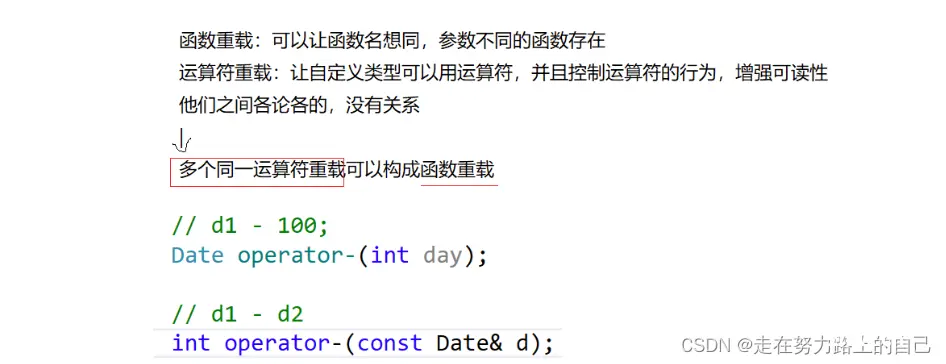
==运算符重载
// d1 == d2
bool Date::operator==(const Date& d) const
{
return _year == d._year
&& _month == d._month
&& _day == d._day;
}
其他运算符重载
// d1 <= d2
bool Date::operator<=(const Date& d) const
{
return *this < d || *this == d;
}
bool Date::operator>(const Date& d) const
{
return !(*this <= d);
}
bool Date::operator>=(const Date& d) const
{
return !(*this < d);
}
bool Date::operator!=(const Date& d) const
{
return !(*this == d);
}
1.4 日期与天数加减操作符重载
// d1 += day
Date& Date::operator+=(int day)
{
_day += day;
while (_day > GetMonthDay(_year, _month))
// 进位
{
_day -= GetMonthDay(_year, _month);
++_month;
if (_month == 13)
{
++_year;
_month = 1;
}
}
return *this;
}
// 1970以后
// d1 -= 100
Date& Date::operator-=(int day)
{
if (day < 0)
{
return *this += -day;
}
_day -= day;
while (_day <= 0)// 借位
{
--_month;
if (_month == 0)
{
_month = 12;
_year--;
}
//借上一个月的天数
_day += GetMonthDay(_year, _month);
}
return *this;
}
+= 和 -= 是复合赋值运算符。功能:复合运算符直接修改调用它们的对象。在Date类的上下文中,+= 运算符将指定的天数加到当前日期上,并直接修改该日期对象。同样,-= 运算符从当前日期中减去指定的天数。效率:由于不需要创建新对象,复合运算符在性能上可能更高效,特别是在需要频繁更新日期的场景中。
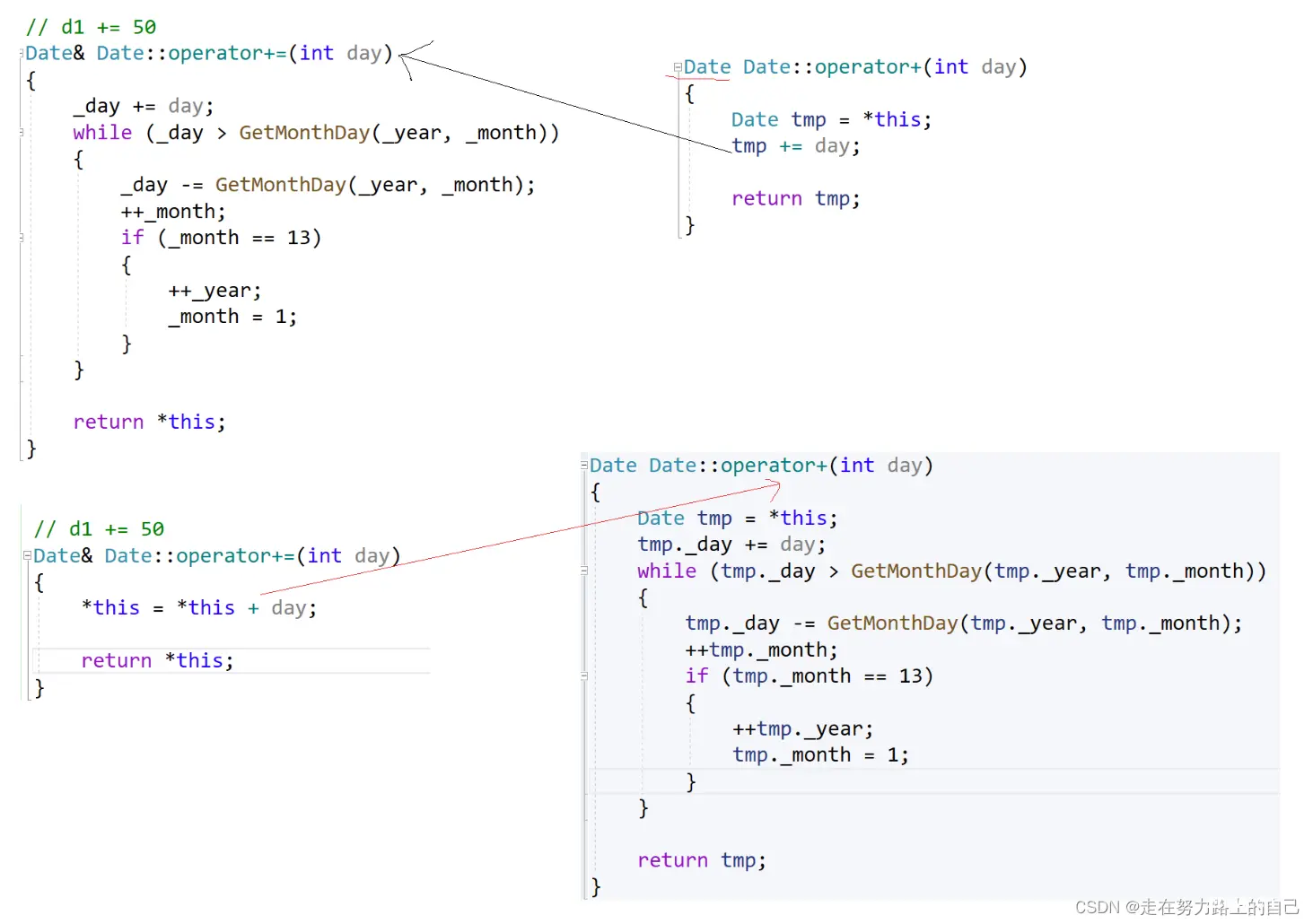

Date Date::operator-(int day) const
{
Date tmp = *this;
tmp -= day;
return tmp;
}
Date Date::operator+(int day) const
{
Date tmp = *this;
tmp += day;
return tmp;
}
+ 和 - 是普通运算符。功能:普通运算符不直接修改调用它们的对象,而是返回一个新的对象,该对象是原始对象与指定值进行运算后的结果。效率:由于需要创建新对象,因此在性能上可能略低于复合运算符。

1.5 日期相减时的操作符重载
// d1 - d2
int Date::operator-(const Date& d) const
{
Date max = *this;
Date min = d;
int flag = 1;
if (*this < d) // 确定最大和最小日期
{
max = d;
min = *this;
flag = -1;
// 即当前对象小于传入的日期,则得到负数天数差
}
int n = 0;
while (min != max)// 实现日期的 != 重载
{
++min;
++n;
}
return n * flag;
}
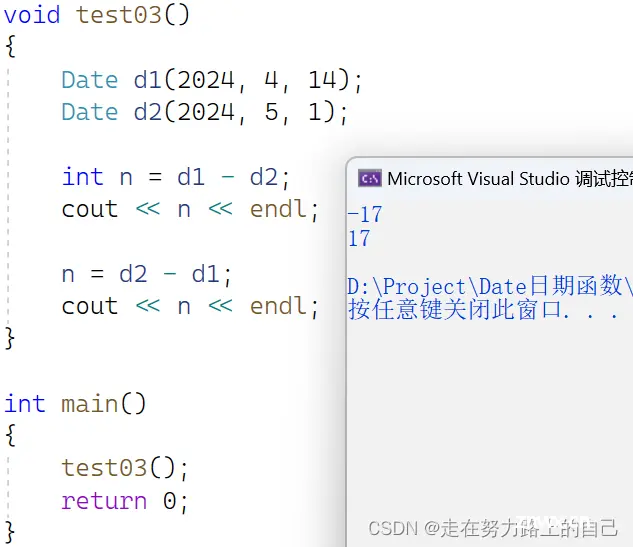
当前对象的日期早于传入的日期对象。此时,将max设置为d,min设置为*this,并将flag设置为-1。这意味着最终的天数差将是负数。 在while循环体内,每次迭代都会对min进行自增操作(通过++运算符重载实现),同时计数器n也自增。这个过程会一直持续到min和max相等,即两个日期相同为止。
1.6 前置运算符和后置运算符实现的区别
// ++d1
Date& Date::operator++()
{
*this += 1;
return *this;
}
// d1++ -> d1.operator(1)
// 为了区分,构成了重载,给后置++,强行增加了一个int形参
// 这里不需要写形参名,因为接收值是多少不重要,也不需要调用
// 这个参数仅仅是为了前缀和后缀区分而存在的
Date Date::operator++(int)
{
Date tmp(*this);
*this += 1;
return tmp;
}
// --d1
Date& Date::operator--()
{
*this -= 1;
return *this;
}
// d1--
Date Date::operator--(int)
{
Date tmp = *this;
*this -= 1;
return tmp;
}
为了区分,构成了重载,给后置++,强行增加了一个int形参。
Date Date::operator++(int)
这里不需要写形参名,因为接收值是多少不重要,也不需要调用。
这个参数仅仅是为了前缀和后缀区分而存在的。
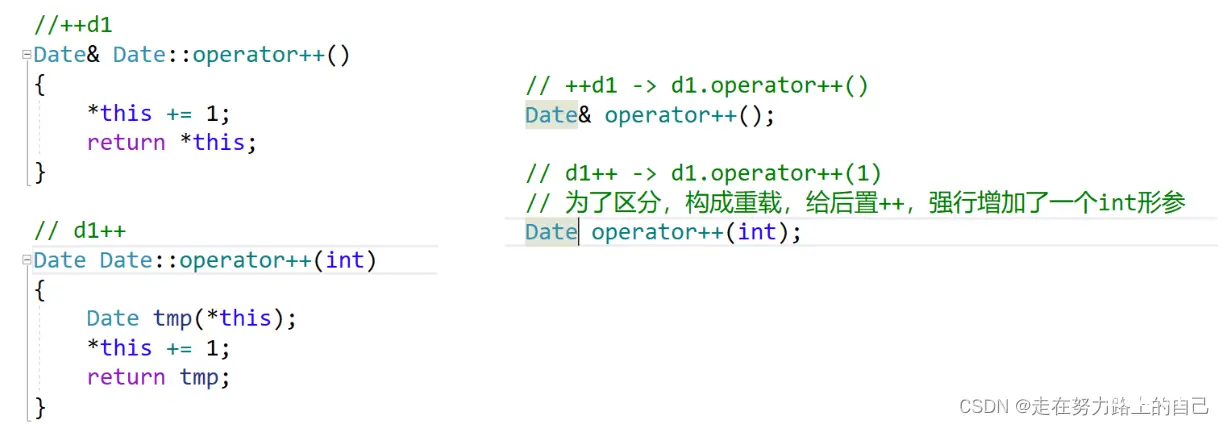
前置运算符的语义是“先操作,再返回”。
语义上:前置运算符的语义是先对对象进行递作,然后返回操作后的对象。这里的关键是“操作后的对象”。效率:返回引用避免了不必要的创建和返回对象的拷贝。在C++中,对象的复制可能是一个昂贵的操作。链式操作:通过返回引用,可以支持链式操作。例如,可以这样写代码:--date = anotherDate; 注意:this指向的对象函数结束后不会销毁,故以引用方式返回提高效率
后置运算符的语义是“先返回,再操作”。
语义上:后置运算符的语义是先返回操作后的对象,然后对对象进行递作。后置运算符的关键在于返回操作前的状态。安全性:返回拷贝还避免了潜在的外部修改,此时得到的是一个独立的值,而不是对原始数据的直接引用。原始数据没有影响。前置++和后置++都是一元运算符,为了让前置++与后置++形成能正确重载
C++规定:后置++重载时多增加一个int类型的参数,但调用函数时该参数不用传递,编译器自动传递。注意:后置++是先使用后+1,因此需要返回+1之前的旧值,故需在实现时需要先将this保存一份,然后给this + 1。而temp是临时对象,因此只能以值的方式返回,不能返回引用
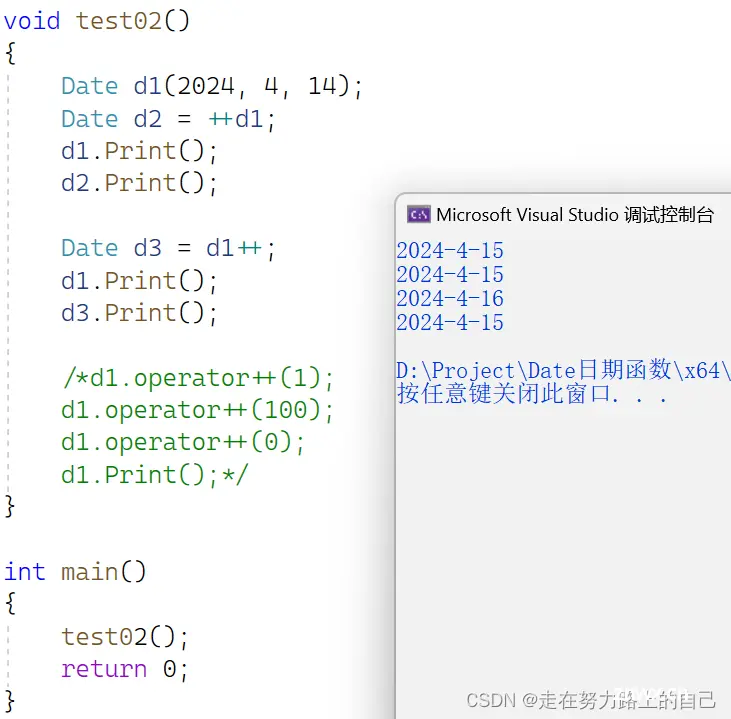
1.7 输入输出流重载
// 友元函数声明,声明后可访问私有成员变量
friend ostream& operator<<(ostream& out, const Date& d);
friend istream& operator>>(istream& in, Date& d);
// 重载输出流操作符<<,用于将Date对象以特定格式输出到输出流中
ostream& operator<<(ostream& out, const Date& d)
{
// 向输出流中输出Date对象的年份、月份和日期,并添加中文字符和换行符进行格式化
out << d._year << "年" << d._month << "月" << d._day << "日" << endl;
// 返回输出流的引用,以便支持链式调用
return out;
}
// 重载输入流操作符>>,用于从输入流中读取数据并设置到Date对象中
istream& operator>>(istream& in, Date& d)
{
cout << "请依次输入年月日:>";
in >> d._year >> d._month >> d._day;
// 调用Date对象的CheckDate()方法检查输入的日期是否合法
if (!d.CheckDate())
{
cout << "日期非法" << endl;
}
// 返回输入流的引用,以便支持链式调用
return in;
}
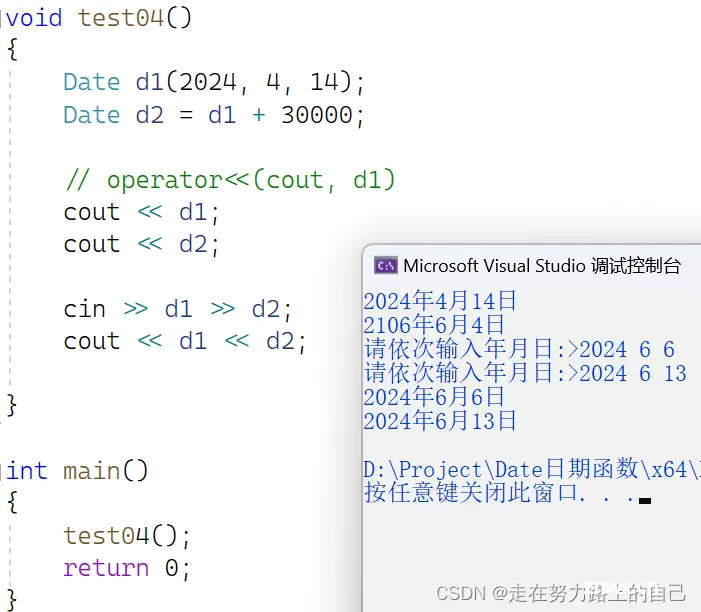
为什么参数顺序为(ostream& out, const Date& d)?
标准的流插入运算符 << 是左结合的,也就是说左侧应该是流对象(如 cout),右侧是我们想要输出的对象(如 Date)。改变参数顺序后,调用方式也必须相应改变即(<< cout),这与常规用法不符。

标准库中的 operator<< 已经定义好了左侧是 ostream&,右侧是要输出的对象。改变参数顺序后,编译器不会再将其识别为流插入运算符,导致无法正常使用链式调用等特性。
将 operator<< 的参数顺序反过来会导致函数不能正常作为流插入运算符使用,破坏标准库的调用方式和使用习惯。
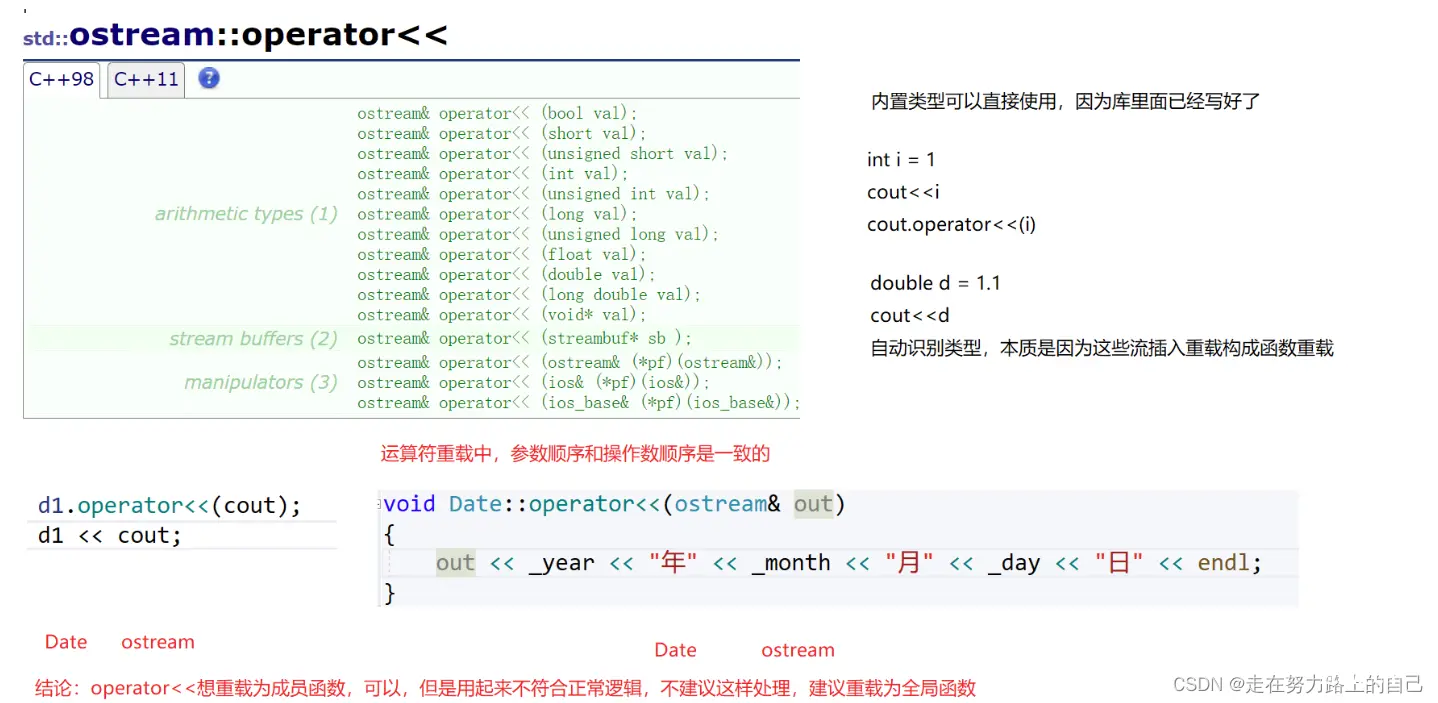
二、const成员
将const修饰的“成员函数”称之为const成员函数,const修饰类成员函数,实际修饰该成员函数隐含的this指针,表明在该成员函数中不能对类的任何成员进行修改。
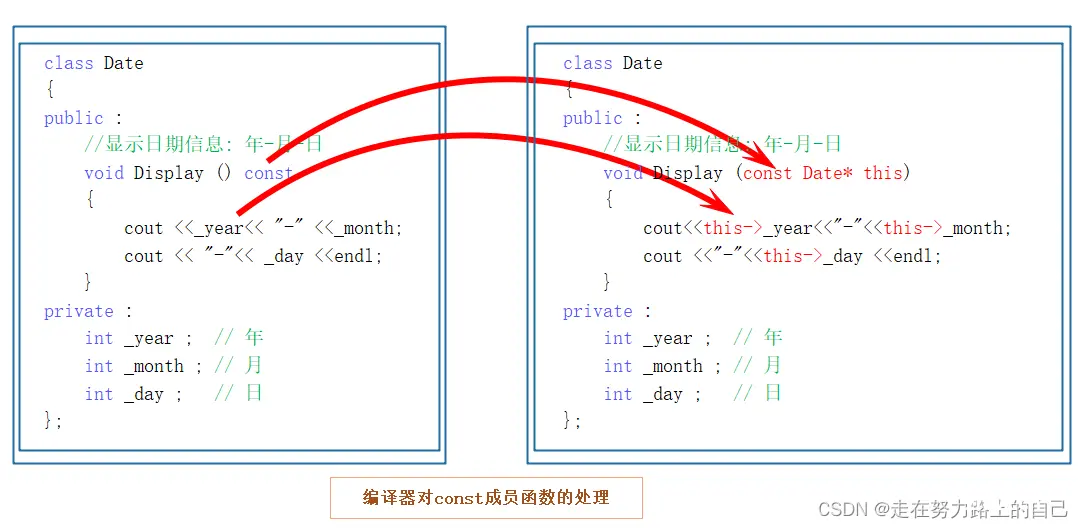
我们来看看下面的代码
class Date
{
public:
Date(int year, int month, int day)
{
_year = year;
_month = month;
_day = day;
}
void Print()
{
cout << "Print()" << endl;
cout << "year:" << _year << endl;
cout << "month:" << _month << endl;
cout << "day:" << _day << endl << endl;
}
void Print() const
{
cout << "Print()const" << endl;
cout << "year:" << _year << endl;
cout << "month:" << _month << endl;
cout << "day:" << _day << endl << endl;
}
private:
int _year; // 年
int _month; // 月
int _day; // 日
};
void Test()
{
Date d1(2022, 1, 13);
d1.Print();
const Date d2(2022, 1, 13);
d2.Print();
}
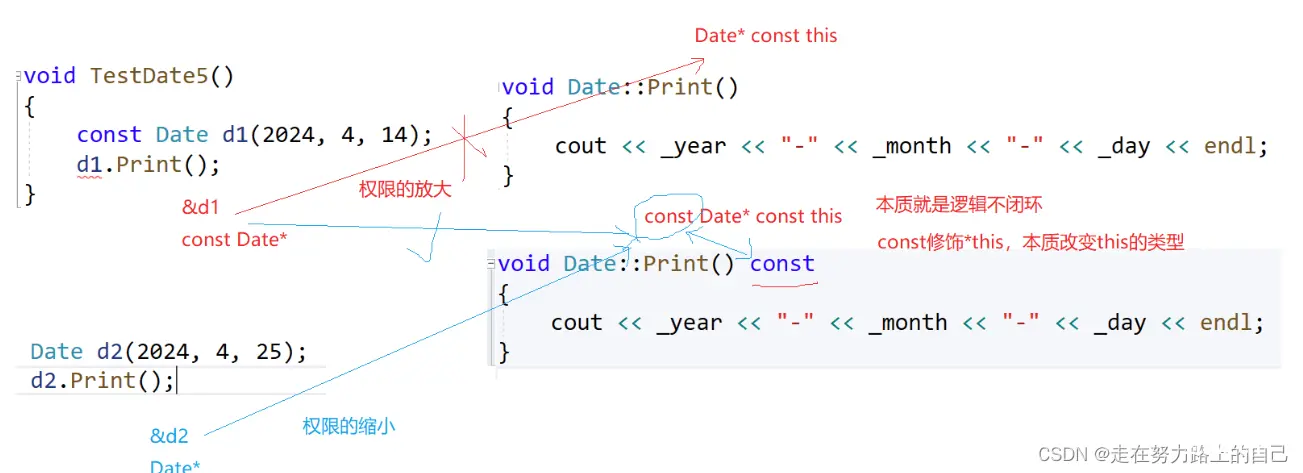
请思考下面的几个问题:
1. const对象可以调用非const成员函数吗?
const对象不能调用非const成员函数。
当你将一个对象声明为const时,实际上是在承诺不会修改这个对象的状态。因此,只能对这个对象调用const成员函数,因为这些函数承诺不会修改对象的状态。
2. 非const对象可以调用const成员函数吗?
非const对象可以调用const成员函数。
const成员函数的主要目的是确保函数不会修改对象的状态。因此,对于非const对象(即可以修改的对象)来说,调用const成员函数是安全的,因为即使对象本身可以被修改,const成员函数也承诺不会修改它。
3. const成员函数内可以调用其它的非const成员函数吗?
不可以。在const成员函数中,不能直接调用同一个类的非const成员函数。原因是const成员函数承诺不会修改对象的状态,而如果它调用了非const成员函数,就会违背这个承诺,因为非const成员函数可能会修改对象。
然而,有一种情况可以间接调用非const成员函数,那就是如果你将对象的const性质通过const_cast去除,然后调用非const成员函数。但这种做法是不推荐的,因为它破坏了const的正确性和对象的常量性质,可能导致未定义行为或程序错误。通常来说,应该尽量避免这种做法。
总结来说,const成员函数内不能直接调用非const成员函数,以保持const成员函数的承诺不修改对象状态。
4. 非const成员函数内可以调用其它的const成员函数吗?
是的,非const成员函数内部可以调用const成员函数。
const成员函数的主要特点是它不会修改调用它的对象的状态。因此,从逻辑上讲,在可以修改对象状态的非const成员函数中调用一个不会修改对象状态的const成员函数是安全的。
三、取地址及const取地址操作符重载
这两个默认成员函数一般不用重新定义 ,编译器默认会生成。
class A
{
public:
// 我们不实现,编译器会自己实现,我们实现了编译器就不会自己实现了
// 一般不需要我们自己实现
// 除非不想让别人取到这个类型对象的真实地址
A* operator&()
{
cout << "A* operator&()" << endl;
return nullptr;
}
const A* operator&() const
{
cout << "const A* operator&() const" << endl;
return (const A*)0xffffffff;
}
private:
int _a1 = 1;
int _a2 = 2;
int _a3 = 3;
};
int main()
{
A aa1;
const A aa2;
cout << &aa1 << endl;
cout << &aa2 << endl;
return 0;
}
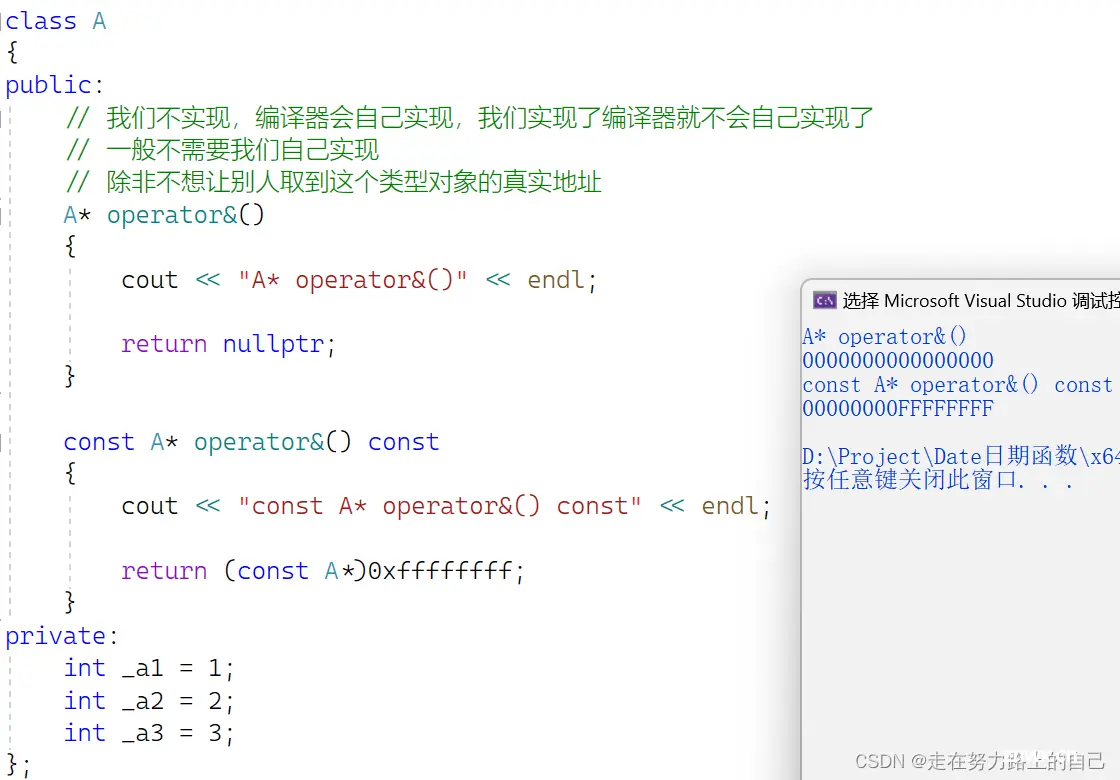
这两个运算符一般不需要重载,使用编译器生成的默认取地址的重载即可,只有特殊情况,才需
要重载,比如想让别人获取到指定的内容!
今天就先到这了!!!

看到这里了还不给博主扣个:
⛳️ 点赞☀️收藏 ⭐️ 关注!
你们的点赞就是博主更新最大的动力!
有问题可以评论或者私信呢秒回哦。
下一篇: 【JAVA】javadoc,如何生成标准的JAVA API文档
本文标签
声明
本文内容仅代表作者观点,或转载于其他网站,本站不以此文作为商业用途
如有涉及侵权,请联系本站进行删除
转载本站原创文章,请注明来源及作者。